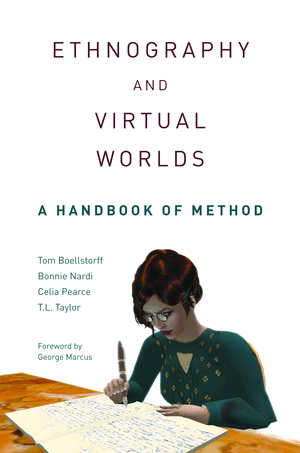 This Winter semester, some of us who attend the book club meetings organized by Mia Consalvo have been reading ‘Ethnography and Virtual Worlds: A Handbook of Method’ by Tom Boellstorf, Bonnie Nardi, Celia Pearce and T.L Taylor. The book ended up being quite useful –mainly for those planning to conduct ethnographies soon, as it was in my case– and the discussions were extremely rich especially since various members of the group had previous experience with this type of research methodology. So let’s say that 9 out of 10 is a fair grade for this book club sessions.
This Winter semester, some of us who attend the book club meetings organized by Mia Consalvo have been reading ‘Ethnography and Virtual Worlds: A Handbook of Method’ by Tom Boellstorf, Bonnie Nardi, Celia Pearce and T.L Taylor. The book ended up being quite useful –mainly for those planning to conduct ethnographies soon, as it was in my case– and the discussions were extremely rich especially since various members of the group had previous experience with this type of research methodology. So let’s say that 9 out of 10 is a fair grade for this book club sessions.
‘Ethnography and Virtual Worlds’ is based on the different ethnographies conducted over the years by four authors, which is a good starting point. That is to say, the book is not a compendium of methodological proposals derived from an extensive literature review –as most of the handbooks are– but is more a kind of a guideline founded on the experiences of these researchers.
The first three chapters of ‘Ethnography and Virtual Worlds’ are principally an overview of what constitute ethnography as a methodology, including its history and the different methods that define it, as well as some notions on how the methodology has been applied in virtual worlds. I feel that the first part of the book will be especially helpful for those beginning a new ethnographic project. In this sense, I find particularly useful the chapter three, where Boellstorf et al. answer to ten myths about ethnography. Their defence of this methodology can help to construct arguments in favour of ethnographic research for diverse projects proposals.
After this introduction to the topic, the book continues with some suggestions on how to design a study of this nature and also provides extensive descriptions of the two main methods within ethnography: participant observation and interviews. All this is illustrated with concrete examples of the authors’ experiences in virtual worlds. At this part of the book, there was some disagreement during our meetings regarding what Boellstorf et al. considered to be a necessary duration of participant observation. While the authors recommend an intensive participant observation of no less of six months, some of the members of the book club commented that such a study is not compatible with other activities that are inevitable for academics –i.e teaching!
‘Ethnography and Virtual Worlds’ goes on to provide very practical information and recommendations about ethics and the IRBs (institutional review board or ethics committees). It finishes with some pieces of advice on data analysis and final phases of a study: writing, presenting and publishing. In general terms, although it is possible to disagree with some of the statements made, ‘Ethnography and Virtual Worlds’ is a good introduction to online ethnographies, very accessible and a great source for references to other studies.
